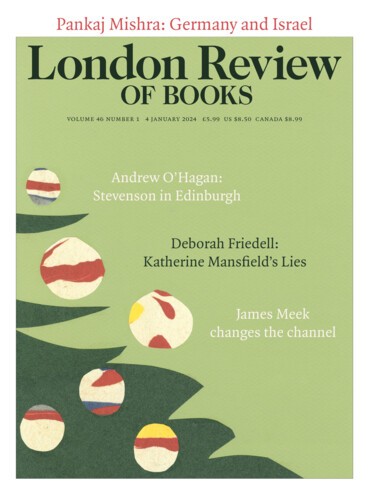Jonathan Tokeley-Parry, who died last month, had a business card in the early 1990s that described him as ‘Jonty “Brown Trews” Tokeley: Smuggler and Fabricator of Egyptian Antiquities’. By his own estimate, Tokeley-Parry smuggled three thousand antiquities out of Egypt in 65 trips over six years. His success was down to his skill as a ‘fabricator’. He made genuine antiquities appear fake by covering them in layers of conservation plastic, plaster, gaudy paint and gilt. His goal was to make a piece ‘look as much as possible like a kitsch bazaar thing, the sort that idiots buy in hotel shops’.
Erin L. Thompson
Erin L. Thompson is a professor at the City College of New York.
‘Why are you crying, habibi?’ Mansoor Adayfi asked the elephant. He had got into the habit of talking to animals at Guantánamo Bay. Held in solitary confinement for years, he talked to the feral cats who prowled around his cage.
Even the Eyelashes: Inca Mummies
Erin L. Thompson, 4 January 2024
The Spanish garrotted Atahualpa, the last Inca emperor of what is now Peru, in 1533, but their control over their new territory was far from certain. One way they tried to solidify their claim was to promote alliances between those loyal to the Spanish crown and the remaining Inca aristocracy. When the conquistador Pedro Pizarro went to ask one Inca nobleman for permission to arrange a...
Ignoring the many ‘no pets’ signs, a man on the trail to the world’s largest Confederate monument was leaping from rock to rock with a ball python wrapped around his neck. I began to think I hadn’t really understood Stone Mountain at all.
Last winter, I visited a stolen goddess at the Metropolitan Museum of Art. The label said she was carved in the mid-tenth century in the ‘style of Koh Ker’, an isolated site in northern Cambodia that was briefly the capital of the Khmer Empire. Its distinctive sculptures began to appear on the international art market in the late 1970s, during the Cambodian genocide.
Read anywhere with the London Review of Books app, available now from the App Store for Apple devices, Google Play for Android devices and Amazon for your Kindle Fire.
Sign up to our newsletter
For highlights from the latest issue, our archive and the blog, as well as news, events and exclusive promotions.


